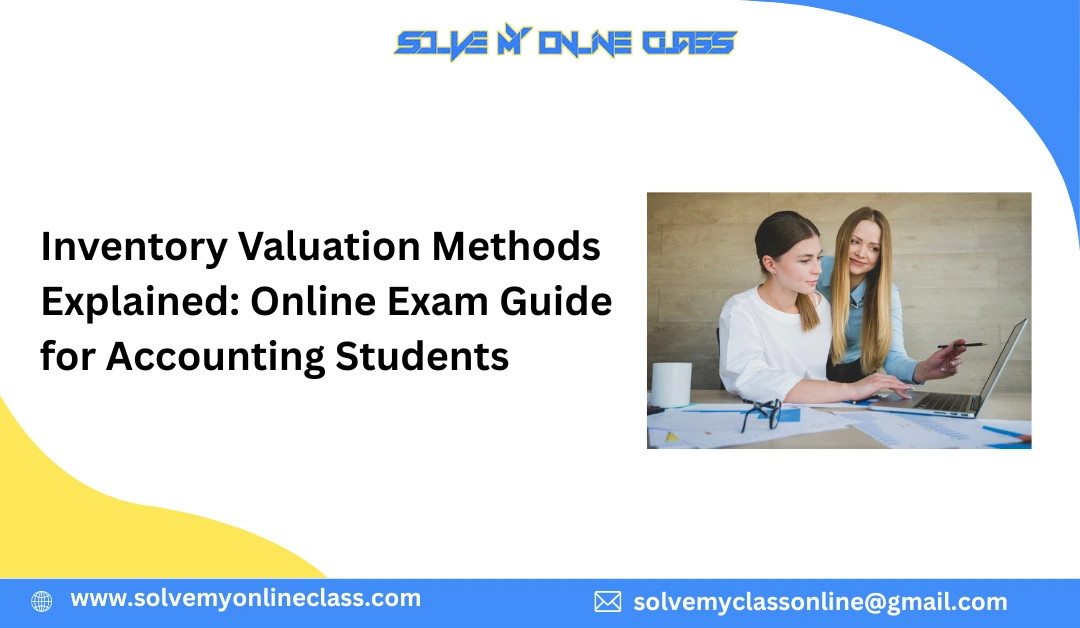Inventory valuation is one of the most critical concepts in accounting. It directly impacts a company’s financial statements, profitability, and tax obligations. For accounting students preparing for online exams, understanding inventory valuation methods is not just about passing a test—it’s about mastering a skill that will be essential in professional practice.
If you’ve ever thought, “I wish someone could take my accounting exam for me” or “Should I hire someone to take my accounting exam?”, remember that the real value lies in learning these concepts yourself. This guide breaks down inventory valuation methods in detail, helping you prepare effectively so you won’t feel the need to say Do my accounting exam to anyone else.
Why Inventory Valuation Matters
Inventory is often one of the largest assets on a company’s balance sheet. How it is valued affects:
- Cost of Goods Sold (COGS): Impacts gross profit and net income.
- Tax liabilities: Different valuation methods can lead to different taxable incomes.
- Financial ratios: Inventory turnover, current ratio, and profitability ratios depend on accurate valuation.
- Decision-making: Managers rely on inventory data to plan production, pricing, and purchasing strategies.
For students, mastering these methods is essential because exam questions often test both theoretical understanding and practical application.
The Main Inventory Valuation Methods
Accounting standards recognize several methods for valuing inventory. Let’s explore the most common ones you’ll encounter in exams.
1. First-In, First-Out (FIFO)
- Assumes the oldest inventory items are sold first.
- Ending inventory consists of the most recent purchases.
- Common in industries where products are perishable or time-sensitive (e.g., food, pharmaceuticals).
Impact on financials:
- In times of rising prices, FIFO results in lower COGS and higher net income.
- Ending inventory reflects current market prices more accurately.
2. Last-In, First-Out (LIFO)
- Assumes the newest inventory items are sold first.
- Ending inventory consists of older purchases.
- Often used in industries where inventory items are interchangeable (e.g., chemicals, metals).
Impact on financials:
- In times of rising prices, LIFO results in higher COGS and lower net income.
- Provides tax advantages in inflationary environments but is not permitted under IFRS (only under US GAAP).
3. Weighted Average Cost (WAC)
- Calculates an average cost per unit by dividing the total cost of goods available by the total units.
- Each unit sold and remaining in inventory is valued at this average cost.
Impact on financials:
- Smooths out price fluctuations.
- Common in industries where items are indistinguishable (e.g., grains, liquids).
4. Specific Identification Method
- Tracks the actual cost of each item.
- Used for unique, high-value items (e.g., cars, jewelry, real estate).
Impact on financials:
- Provides precise matching of costs and revenues.
- Not practical for businesses with large volumes of identical inventory.
Numerical Example
Imagine a company purchases inventory as follows:
- 100 units @ £10 each
- 100 units @ £12 each
- 100 units @ £14 each
It sells 200 units.
- FIFO: COGS = (100 × £10) + (100 × £12) = £2,200. Ending inventory = 100 × £14 = £1,400.
- LIFO: COGS = (100 × £14) + (100 × £12) = £2,600. Ending inventory = 100 × £10 = £1,000.
- WAC: Average cost = (£1,000 + £1,200 + £1,400) ÷ 300 = £12 per unit. COGS = 200 × £12 = £2,400. Ending inventory = 100 × £12 = £1,200.
This example shows how different methods can lead to very different financial outcomes.
Exam Preparation Tips
When preparing for your online accounting exam, here are strategies to ensure you master inventory valuation methods:
- Understand the logic behind each method. Don’t just memorize formulas—know why companies choose one method over another.
- Practice numerical problems. Exams often include calculations similar to the example above.
- Compare impacts. Be ready to explain how each method affects income, taxes, and balance sheet figures.
- Stay updated on standards. Remember that IFRS prohibits LIFO, while US GAAP allows it.
Common Exam Questions
Accounting exams often test inventory valuation in these formats:
- Multiple-choice questions: Identify which method results in higher net income during inflation.
- Numerical problems: Calculate ending inventory and COGS using FIFO, LIFO, and WAC.
- Essay questions: Discuss the advantages and disadvantages of each method.
- Case studies: Apply valuation methods to real-world scenarios.
By practicing these, you’ll feel confident and won’t be tempted to search Hire Someone To Take My Accounting Exam.
How to Use This Guide
This blog is designed as a quick revision tool:
- Step 1: Read through each method and understand its assumptions.
- Step 2: Practice with numerical examples.
- Step 3: Review impacts on financial statements.
- Step 4: Apply knowledge to exam-style questions.
If you follow these steps, you’ll be well-prepared and won’t feel the need to say “Do My Accounting Exam” to anyone else.
Conclusion:
Inventory valuation is more than just an exam topic—it’s a cornerstone of accounting practice. Whether you’re preparing for an online test or gearing up for a career in finance, mastering FIFO, LIFO, WAC, and Specific Identification will give you a strong foundation.
So, instead of thinking Take My Accounting Exam, invest time in learning these methods. The effort you put in now will pay off not only in your grades but also in your professional journey.






